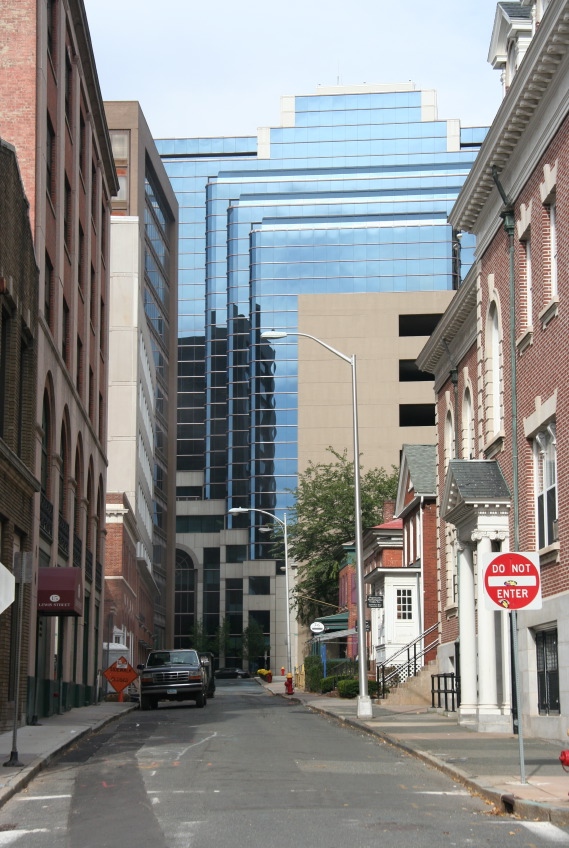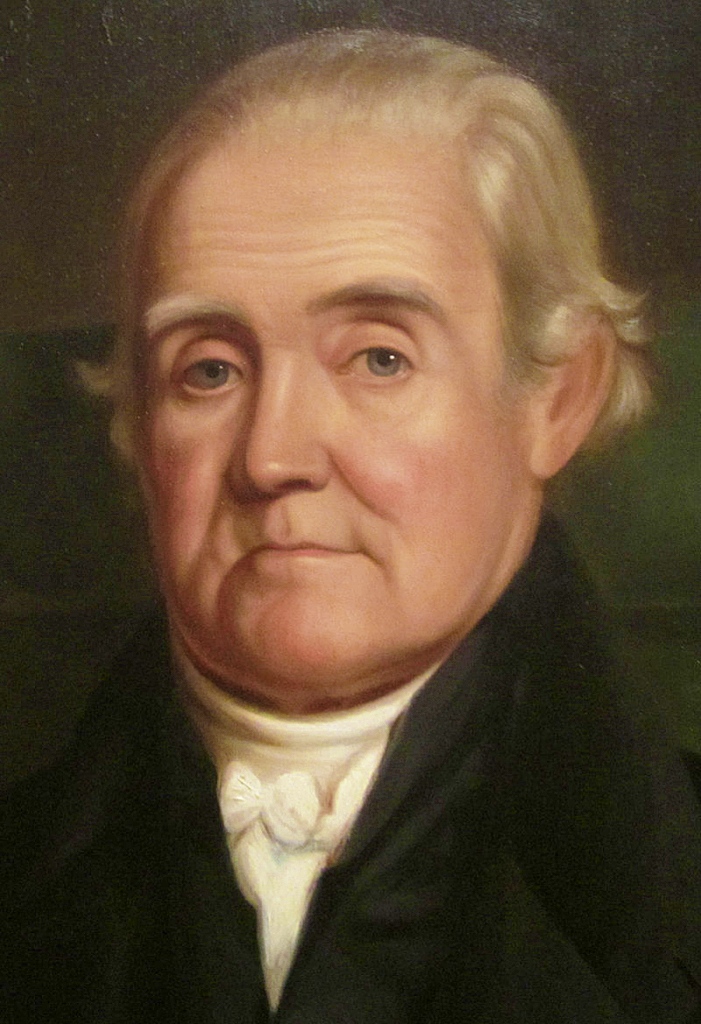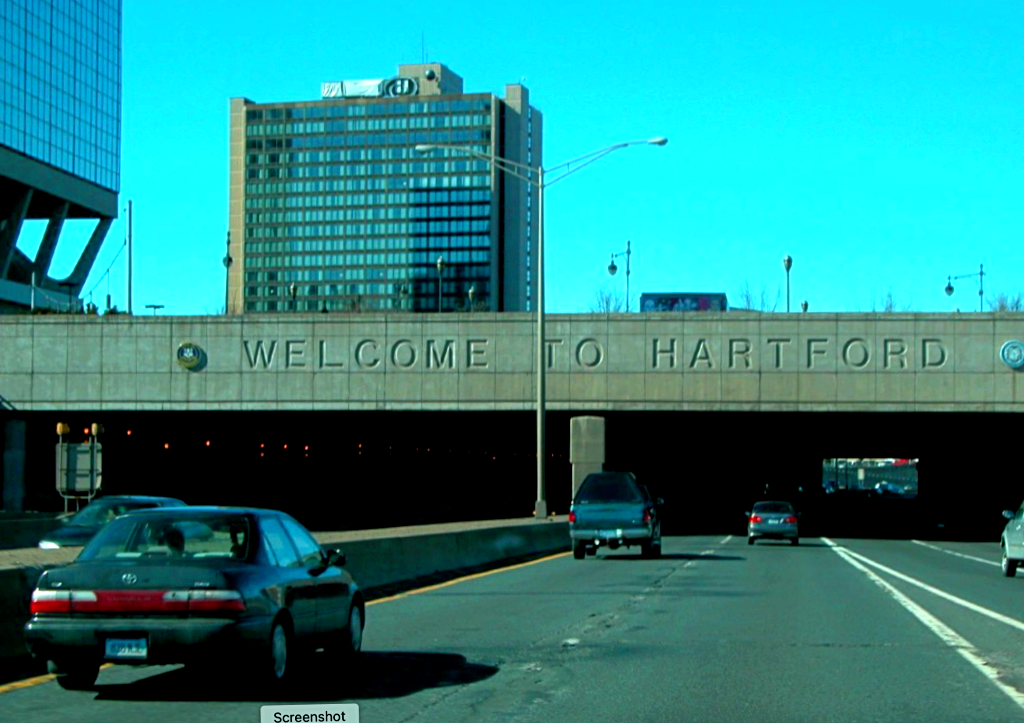About Hartford
Hartford's Old State House may be your first stop, as this colonial and early American capitol also houses the tourist information office (map).
Nearby are Hartford's other things to see, including the Connecticut State Capitol, Bushnell Park (designed by Olmsted), Center Church, and the Cheney building.
Hartford's Wadsworth Atheneum is among New England's finest art museums.
A short ride from the city center, at Nook Farm, are the grand Victorian mansion of writer Mark Twain, and the more modest cottage of Harriet Beecher Stowe.
Go a bit farther, to Old Wethersfield, to see Revolutionary-era houses, now museums, preserving the life of the period when America was born.
Hartford is and has been a city with a good amount of wealth, much of it generated by the tens of thousands of workers who sit in the thousands of offices of Hartford's great insurance companies and banks. They drive in on weekdays causing huge traffic slowdowns, so the best day to visit Hartford is Saturday. (On Sunday, some of its attractions are closed.) Hotel rates should be cheaper then as well.
Insurance companies
seem to have a penchant for expressing their wealth
and prestige through skyscrapers like
the Prudential Tower in Chicago, and the John Hancock
Tower in Boston,
among others. Hartford has four dozen insurance companies,
and therefore lots of skyscrapers, most historic of which
is the Travelers
Tower.
A Bit of History
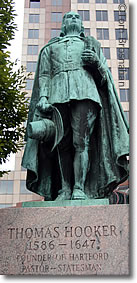 |
|---|
Hartford was founded by Rev. Thomas Hooker, who left Newtown (Cambridge MA) on foot with a band of followers in 1636 after a dispute with another clergyman over the strict rules that governed the colony of Massachusetts Bay.
In 1639 Hooker and others drafted the Fundamental Orders as the legal constitution of their settlement, and it is upon this early document that Connecticut bases its claims as the first place in the world to have a written constitution that established a government. Connecticut's motto is, appropriately, "The Constitution State."
What to See & Do
Interesting architecture, a fine arts museum, sculptures by Alexander Calder, Mark Twain's mansion, even an antique carousel for the kids—and adults, for that matter.
The Old State House
Designed by Charles Bulfinch, tthe stately building at 800 Main Street in the center of Hartford was Connecticut's state capitol from 1796 to 1878, and now holds the city's information center and museum shop. Connecticut's Federal-style Old State House in Hartford, finished in 1796, was the first public building designed by famed New England architect Charles Bulfinch (1763-1844).
The Old State House (1796), by Charles Bullfinch.
For Connecticut's first State House, it may be that Bulfinch copied somewhat the design of the Town Hall of Liverpool, England.
Compare the Old State House with the Massachusetts State House (1798) in Boston or the United States Capitol (1800) in Washington DC, both Bulfinch achievements.
On the Main Street side, have a look at the statue of Hartford's founder, the Reverend Thomas Hooker (1586-1647).
The Greater Hartford Visitor Center is located on the first floor of the Old State House, with maps, brochures and friendly advisors available.
The Old State House is open to visits Tuesday through Saturday from 12 noon to 5 pm (closed Sunday, Monday, and most holidays).
Outdoor concerts are often held in the precincts of the Old State House, and three galleries inside hold exhibits which change frequently.
The Cheney Building
North on Main Street at No. 942, a block from the Old State House, is the mass of Connecticut brownstone put together in 1876 by Henry Hobson Richardson, for the Cheney Brothers, manufacturers of silk.
The Cheney Building (1876), Hartford CT.
Typically Richardsonian, the architect was at work on this about the same time as he designed his masterpiece, Trinity Church in Boston's Copley Square.
You can experience the Cheney Building up close: it now holds a Residence Inn by Marriott, as well as several restaurants and other businesses.
Travelers Tower & Charter Oak
Between Main and Prospect streets, right next to the Old State House, rises a historic landmark, the Travelers Tower. When it was completed in 1919, it was the seventh-tallest building in the world, and the tallest in Hartford. But the location is more famous than that.
The Travelers Tower stands on the spot where, in colonial times, there was a tavern. In the tavern, during a dispute between colonials and royal officials, Connecticut's royal charter disappeared.
The charter, the essential self-government contract for the colony, detailed the boundaries of the colony and the powers granted to the colonists by the king. Fearing the royal officials were attempting to rob them of these powers, colonists took the charter from the tavern and hid the sacred document in a cavity in a nearby oak tree.
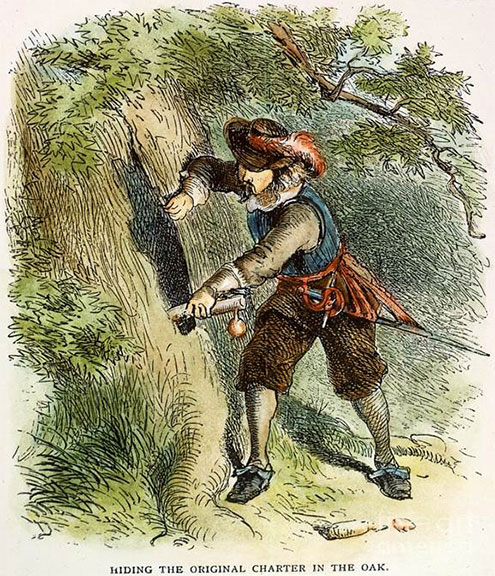
The Charter Oak became famous as a symbol of Connecticut's—and America's—unwillingness to be governed by a parliament in London in which the colonial peoples had no representation.
The king's men ruled Connecticut illegally for a time (they could not find the charter and thus could not destroy the legal instrument of Connecticut's self-rule), but the charter survived, and it's now on view at the State Library next to the State House.
Wadsworth Atheneum
Hartford's fine art museum has an excellent collection of nearly 50,000 items of painting, sculpture, ancient, contemporary and modern art in five buildings.
Wadsworth Atheneum, Hartford CT
It's worth a trip to Hartford CT to explore the Wadsworth Atheneum Museum of Art's Greek and Roman antiquities, European decorative arts, baroque and surrealist paintings, Hudson River School landscapes, European and American Impressionist paintings, modernist masterpieces, drawings and costumes of the Ballets Russes, American colonial furniture and decorative arts, the Samuel Colt firearms collection, African-American art and artifacts, and contemporary art.
Founded in 1842, the Wadsworth has five connected buildings, including its iconic original Gothic Revival Wadsworth Building (1844) and the Beaux-Arts Morgan Memorial Building (1910-1915).
As you enter the building at 600 Main Street (map), ask for a guide leaflet to the collections.
Wadsworth's Permanent Collection
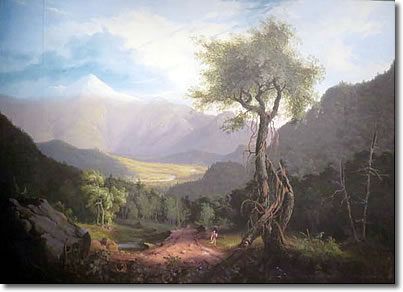
View of the White Mountains, by Thomas Cole (1827).
Major exhibits change quarterly, so there's always something new to see, but you can easily be absorbed in the Wadsworth's permanent collection: major examples by Caravaggio, Orazio Gentileschi, and Bernardo Strozzi; 18th century American portraits by Ralph Earl and John Singleton Copley, 19th century still lifes by the Peale family; Surrealist art by Salvador Dalí, Joan Miró, Max Ernst, and René Magritte; works by Claude Monet, Pierre-Auguste Renoir, William Holman Hunt, and Joseph Wright of Derby; and American modernist works by Marsden Hartley, Georgia O’Keefe, and Andrew Wyeth.
Admission
The Wadsworth is open Wednesday through Sunday, closed Monday and Tuesday. There is a moderate charge for admission, but on certain days and at certain hours admission is free. More...
The museum's pleasant Museum Café serves soups, salads, sandwiches, pasta, and a few heartier dishes at reasonable prices.
Burr Mall
When you visit Hartford's fine Wadsworth Atheneum art museum, be sure to have a look at Alexander Calder's Stegosaurus in Burr Mall, a shady, fragrant spot with a fountain.
Between Wadsworth Atheneum and the attractive city executive office building, Burr Mall is a shady, fragrant spot with a fountain and a fine—if incongruously placed—stabile by Alexander Calder called Stegosaurus (1971).
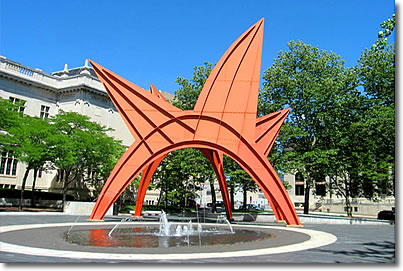
Alexander Calder's Stegosaurus on Burr Mall.
Across Prospect Street from Burr Mall, take a look at the interesting buildings: the Masonic Temple and the Hartford Times Building.
The facade for the latter was once the front of a church in New York, which explains its architecture, odd for a newspaper building!
Center Church
Across Main Street from the Travelers Tower is the site of the first church in Hartford, whose pastor was Thomas Hooker (he's thought to be buried under the church). The present Center Church (First Church of Christ, United Church of Christ) dates from 1807. The gravestones date back to 1640.
Bushnell Park
With 500 trees of 150 varieties, Bushnell Park is an Olmsted oasis in the middle of the busy city with an antique carousel still in operation.
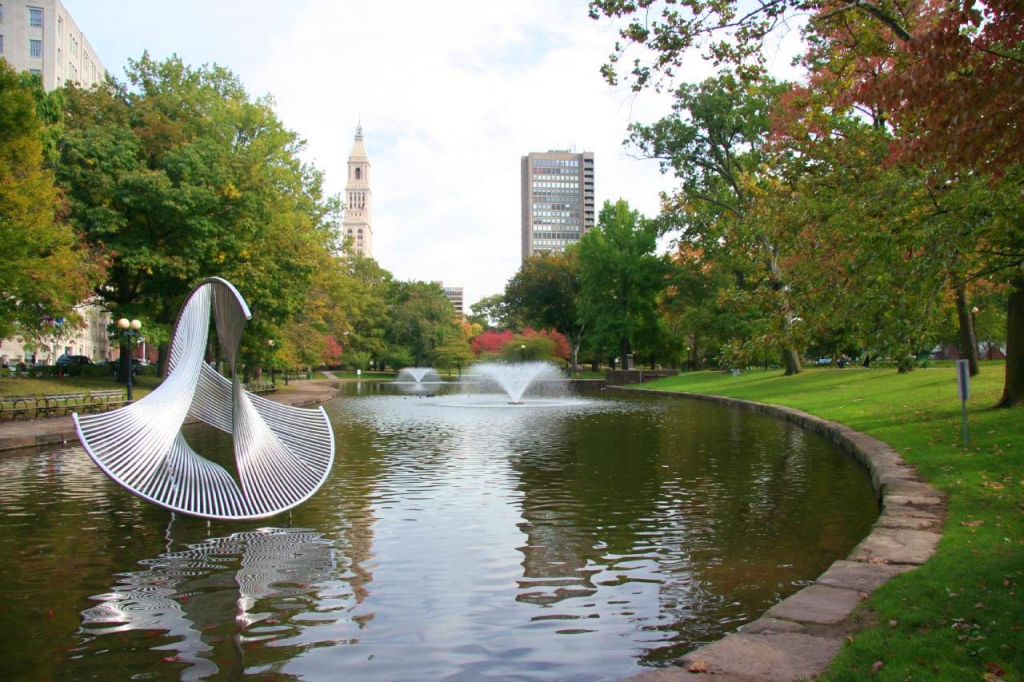
Bushnell Park: a breath of
fresh air in the center of Hartford, just
below the State House.
In 1853, Reverend Horace Bushnell of Hartford realized that his home city was rapidly being developed and industrialized, so he initiated a movement to preserve a large swath of land in the city's center as "an outdoor parlor" for all to enjoy.
Rev. Bushnell's dream became the first municipally-funded public park in the USA, and led to Hartford's developing one of the most extensive public park systems of any US city (map).
Like so many other great city parks in the USA, Bushnell Park was laid out by the famous landscape architect Frederick Law Olmsted, the Hartford resident who also landscaped Central Park in New York City, the "Emerald Necklace" of parks in Boston, and Montreal's Mount Royal Park. Olmsted is buried in Old North Cemetery, one of the elements in his network of Hartford parks.
Soldiers & Sailors Memorial Arch (1879) in Bushnell Park.
The twin-towered Gothic arch on Trinity Street is Hartford's memorial to its Civil War dead.
Be sure to visit the park's carousel, one of the finest restored merry-go-rounds you'll ever see, complete with calliope and automatic drums and cymbals. It is by no means only children who take rides on this historic fun machine.
The carousel has three types of seating accommodation: "lovers' chariots" for the unadventurous, stationary wooden horses, and horses that move up and down.
Remember to grab for the brass ring!
Note that the carousel doesn't operate on Sunday, and you must see it with all the lights on and the music trilling to really get the feeling.
The Capitol & Lafayette Square
Connecticut's State Capitol is a potpourri of architectural styles, with the Museum of Connecticut History (and its Samuel Colt collection of more than 1000 firearms) and The Bushnell concert hall nearby.
Connecticut's state capitol stands on a hill in the center of Hartford, its gold dome easily visible to anyone driving through on an Interstate highway.
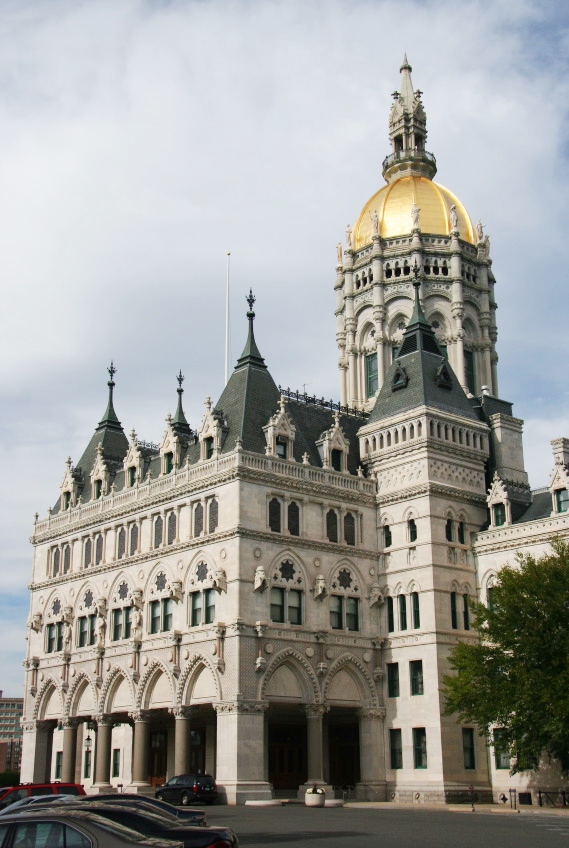
Connecticut's State Capitol, an eclectic work.
Richard M Upjohn is the architect responsible for the Connecticut State Capitol, a great potpourri of architectural styles and periods, including Gothic niches housing soldiers in Civil War uniforms.
For all its eclecticism, the Capitol is fine to look at. At one time it was topped by a statue of The Genius of Connecticut, a lady.
You can see that statue inside the building, and also the battle flags and memorabilia preserved here.
State Library & Supreme Court
Across Capitol Avenue is the State Library and Supreme Court, a pretty building housing the paper treasures of Connecticut history, including the famous royal charter once hidden in an oak tree.
Besides preserving the documents, the library is now the repository of the Samuel Colt collection of more than 1,000 firearms. All together, the collections here make up the Museum of Connecticut History.
The Bushnell
Near the Capitol and State Library, in Lafayette Square, is The Bushnell, a hall where many of the city's concerts, plays, and recitals are held. The interior is of the purest 1930s art deco, a style which has seen a resurgence in recent years.
Nook Farm
From the center of Hartford, drive out Asylum Street and Farmington Avenue about 15 block to Nook Farm and the homes of Mark Twain and Harriet Beecher Stowe. Look for the art deco steeple of Trinity Church, and four blocks later, look for the signs on the left.
Mark Twain House & Museum
The famous author lived in this magnificent Victorian pile at 351 Farmington Avenue (map) for 17 years, and wrote Tom Sawyer and many of his other greatest works here.
Mark Twain's House at Nook Farm.
Samuel Clemens ("Mark Twain," 1835-1910), the famous American author from Hannibal, Missouri settled in Hartford, Connecticut in the early 1870s.
His grand house at Nook Farm, 351 Farmington Avenue (map), was finished in 1874 at a cost of $131,000, and is extremely rich in the sort of detail that makes Victorian architecture so much fun.
Twain moved out of the house only after bad investments forced him to take a lecture tour of Europe for some quick money.
Twain's Best-sellers
He loved this place for the best years of his life, and wrote Tom Sawyer, Huckleberry Finn, Life on the Mississippi, The Prince and the Pauper, and A Connecticut Yankee in King Arthur's Court while he lived here.
To see the Mark Twain House you must take the tour, which is just as well, for the guides have an encyclopedic knowledge of the house and its occupants.
Right next door, also at Nook Farm, is the Harriet Beecher Stowe House.
Harriet Beecher Stowe House
In the same complex of buildings as the Mark Twain House, known as Nook Farm, is a house once lived in by the famous advocate for the abolition of slavery, women's rights, and temperance in the use of alcohol.
Ms Stowe wrote Uncle Tom's Cabin in Brunswick ME, but she lived and wrote here from 1873 until her death in 1896.
Harriet Beecher Stowe House, Nook Farm, Hartford CT.
Born in Litchfield CT, Harriet Beecher Stowe (1811-1896) was able to get a traditional academic education—something usually reserved for men at the time—because her older sister Catharine was in charge of the Hartford Female Seminary. She married Calvin Stowe in 1836, and soon adopted his fervent anti-slavery principles.
As a mother and teacher living in Brunswick ME, she and her husband were appalled at the torture of slavery in America. After having lost her young son Samuel in 1850, Stowe empathized even more closely with those enslaved whose families were torn asunder.
She wrote Uncle Tom's Cabin, her poignant novel about a runaway slave, as a series of installments in an anti-slavery magazine in 1851. It was published in book form in 1852 and became a huge national bestseller, with 300,000 copies sold within a year of publication.
Her last years were marred by dementia which may have been Alzheimer's disease, but she was cared for in her cottage at Nook Farm which retains many of her original furnishings.
Noah Webster House, West Hartford CT
America's first lexicographer, Noah Webster (1758-1843) was born in a farmhouse on the outskirts of Hartford.
Today West Hartford, just off Interstate 84, is a garden suburb of Hartford, with lots of green lawns, rolling hills, pleasant upscale neighborhoods, and a few significant historical sights, including the boyhood home of lexicographer Noah Webster.
Webster lived in the house at 227 South Main Street (map) with his strict Calvinist parents and four siblings, helping to work the land until he was 16. He left home to attend Yale College on the eve of the American Revolution, and was caught up in the intellectual ferment of the time.
The house, a simple center-chimney colonial dwelling, is furnished authentically in period style, and costumed guides give you a tour and explain what life was like in the America of two centuries ago. The house's garden is typical of the period with herbs and dye plants.
Old Wethersfield
If you like historic houses, several in Old Wethersfield, not far from Hartford, are fine examples with period furnishings. Drive south on I-91 for about 10 miles to Exit 26 and follow the signs to Old Wethersfield.
You arrive in the center of Old Wethersfield (map) with its flagpole and the soaring brick tower and white steeple of First Church of Christ Congregational, the first building of which was constructed in 1764.
Across the street from the church, the Village Inn serves lunch and dinner in period surroundings. Across Main Street from the Village Inn are several other restaurants, cafés and shops good for a drink, a snack, a light meal, or something more substantial.
Webb-Deane-Stevens Museum
Drive along Main Street to find the Webb-Deane-Stevens Museum, three historic houses side by side:
The Joseph Webb House (tel 203-529-0612), 211 Main Street, was the site of a strategy conference (1781) between the American commander-in-chief, General George Washington, and his French ally, the Comte de Rochambeau. At the conference, Rochambeau outlined his plan to engage the British at Yorktown. It worked, and the battle ended the Revolutionary War.
The house was built in 1752, and now contains period furniture, fabrics, porcelain, and silver.
Silas Deane House
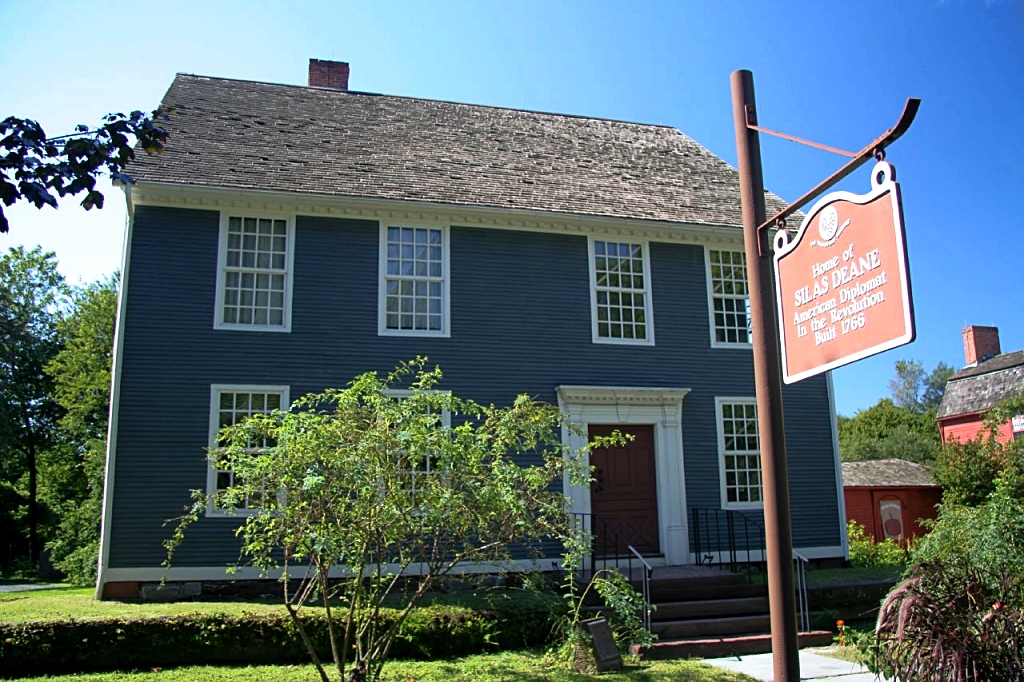
Above, Silas Deane House (1766),
Old Wethersfield CT.
The home of Silas Deane, 203 Main Street, next door to the Webb House, was built in 1766 by a member of the First Continental Congress (1774-76) and commissioner (ambassador) to France (1776). The Silas Deane House is an elegant place for an elegant gentleman, with interesting architectural details.
Although he was a patriot, Deane was ill-used by some of his American diplomatic colleagues, and he found himself condemned for profiteering by Congress. He lived the rest of his life in exile, but in 1842 Congress made amends to his family and restored his good name and fortune.
Stevens House
The Isaac Stevens House, 215 Main Street, was a craftsman's home built in 1788, and it still has many of the family's original furnishings. Of particular interest are the collections of toys and ladies' bonnets.
Wethersfield Historical Society
If you've now become intrigued by Wethersfield's deep history, drop in at the Wethersfield Historical Society (tel 203-529-7656), 150 Main Street, located in the Old Academy, a fine Federal-style brick building dating from 1804 that's just across the street from the Silas Deane and Joseph Webb houses.
The society is in charge of the Wethersfield Museum in the nearby Keeney Memorial Cultural Center at 200 Main Street, with visitor orientation, a museum shop, and exhibits on Wethersfield, and also the Captain James Francis House, 120 Hartford Avenue. This house, dating from 1793, has exhibits which trace a single Wethersfield family through a history of 170 years.
Buttolph-Williams House
The Buttolph-Williams House, 249 Broad Street, dates from the 1600s and has excellent authentic period furnishings. The kitchen is especially good, and may be the most real-to-life of any extant in New England.
Where to Stay
Use this Hotel Map with Prices to find the lodgings you want in or near Hartford CT:
Transportation
Distances
Hartford is 102 miles (165 km) SW of Boston, 113 miles (182 km) NE of New York City, 74 miles (119 km) from Providence, 34 miles (55 km) E of Litchfield CT.
Train
Amtrak and the Connecticut Department of Transportation cooperate on the Hartford Line, roughly hourly service (6 am to 12 midnight) on weekdays between New Haven CT, Hartford CT and Springfield MA, with connecting bus service via CTtransit's 30-Bradley Flyer bus from Hartford's Union Station to Bradley International Airport. More...
Bus
Greyhound and Peter Pan operate daily buses between New York City, (Port Authority Bus Terminal), New Haven, Hartford (Union Plaza, map) and Boston.
Greyhound has almost hourly departures all day and most of the night; Peter Pan has the next most departures.
The trip from New York to Hartford takes about 3 hours, depending on the line and the number of stops en route.
Car
Hartford, at the junction of Interstate highways I-91 and I-84 (map), is very much a commuters' town, and traffic is heavy at rush hours.
The best day to visit the city is Saturday, when most everything is open and parking is easily available. On Sunday many places are closed.
Plane
Hartford is served by Bradley International Airport in Windsor Locks, 12 miles north of Hartford (map).
CTtransit's 30-Bradley Flyer bus shuttles between Hartford's Union Station to Bradley International Airport.
Buses also leave the airport for Springfield MA, and limousines shuttle from Bradley to most cities in Connecticut and the Massachusetts Berkshire Hills.
By the way, the Connecticut Aeronautical Historical Association operates the New England Air Museum at Bradley Airport, with over 70 aircraft, plus engines, accessories, and memorabilia, on display.
